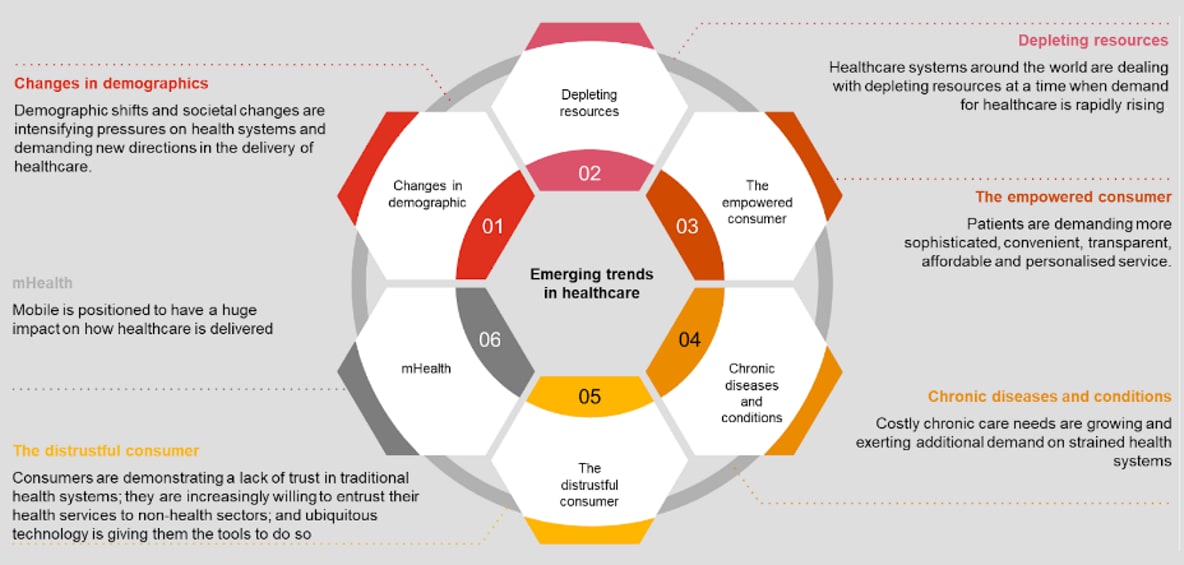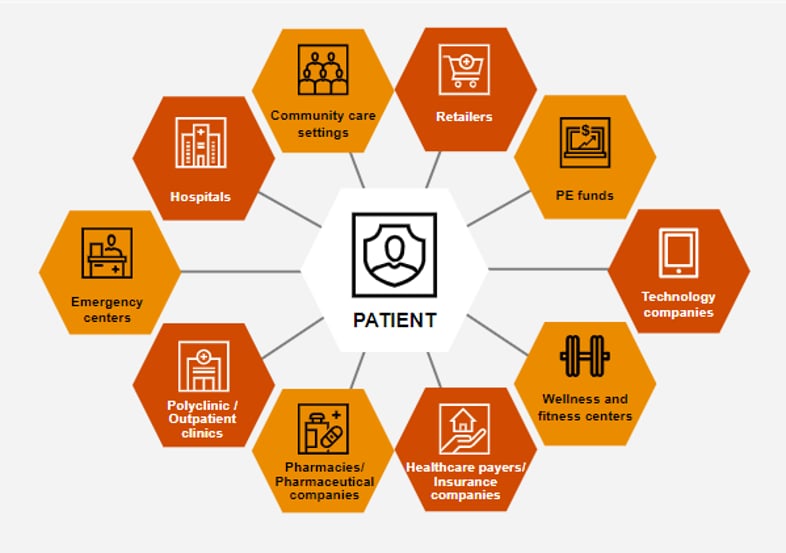
While the healthcare industry has been witnessing evolution in all aspects over the past 10 to 20 years, the emergence of technology and digitalisation within the sector, as well as two years of an unprecedented epidemic, have accelerated disruption in the industry. Several recent trends – increasing consumerism in healthcare (e.g., a stronger preference for convenience and simplicity in using healthcare services), inpatient care shifting to outpatient services, technological innovations, increasing complications, higher incidence of certain diseases due to more sedentary lifestyles, and longer life expectancies – are together shaping a global shift in the healthcare landscape, disrupting the sector, and pushing stakeholders to innovate and take action.
Globally, PwC has identified six emerging trends in healthcare (Figure 1).

Figure 1: Global emerging trends in healthcare
These trends have been impacting the healthcare industry in a number of ways:
Changing demographics drive healthcare reforms. A new paradigm of public and private sector collaboration is developing to transform healthcare financing and delivery. Partnerships with new market participants from the retail, technology (e.g., artificial intelligence, robotic, teleconsultation, analytics), wellness, and fitness sectors (i.e., non-healthcare/ non-traditional healthcare sectors) are expanding and reshaping the health system.
An ageing population, an emerging middle and affluent class, and an increasing burden of chronic diseases reflect demographic shifts and societal changes in Vietnam relevant to the healthcare sector. These trends are driving up the demand for long-term care. Additionally, access to middle-class comforts is both fueling increasing demand for more health options and resulting in more sedentary lifestyles that will inevitably lead to greater incidences of obesity, diabetes, and other costly, chronic health conditions.
These wealthier income groups typically demand a higher quality of healthcare examination and treatment, as well as more sophisticated, convenient, transparent, affordable, and personalised services. These groups also have access to much wider care options, i.e., in hospitals and alternative sites of care (e.g., fitness centres, retail clinics, the workplace, alternative clinics, or home), either domestically or abroad, via offline or virtual channels, etc. This is opening the door for new entrants from other industries, which are together creating a larger health ecosystem in addition to traditional settings (i.e., hospitals and doctor clinics), with patients at the core (Figure 2). The global shift away from fragmented care to integrated models in which organisations, communities and social care providers coordinate their services, with patients as active partners in their health across the continuum, is also occurring in Vietnam.

Figure 2: Players in the healthcare ecosystem
Partnership and collaboration between stakeholders in the healthcare ecosystem are keys for them to stay tuned in the fast-evolving healthcare industry, and to continue to stay relevant and successful within the wider ecosystem. In a broader context, collaboration to create a more connected healthcare ecosystem for all stakeholders will help to ensure success and sustainability throughout the industry.
As patients are looking for a more integrated care model, hospitals with a traditional acute care focus can consider diversifying their range and mode of services. This move could enable hospitals to acquire patients earlier in the care continuum, and to increase patient retention by enabling them to manage the care process more comprehensively. Hospitals may choose to expand organically, or via acquisition or strategic partnerships, especially in the areas that are traditionally not covered by hospitals such as teleconsultation and mHealth, wellness services, home care, and palliative care.
Pham Anh Duy
Senior Manager, Capital Projects and Infrastructure, PwC Vietnam
Tel: +84 918 484 843